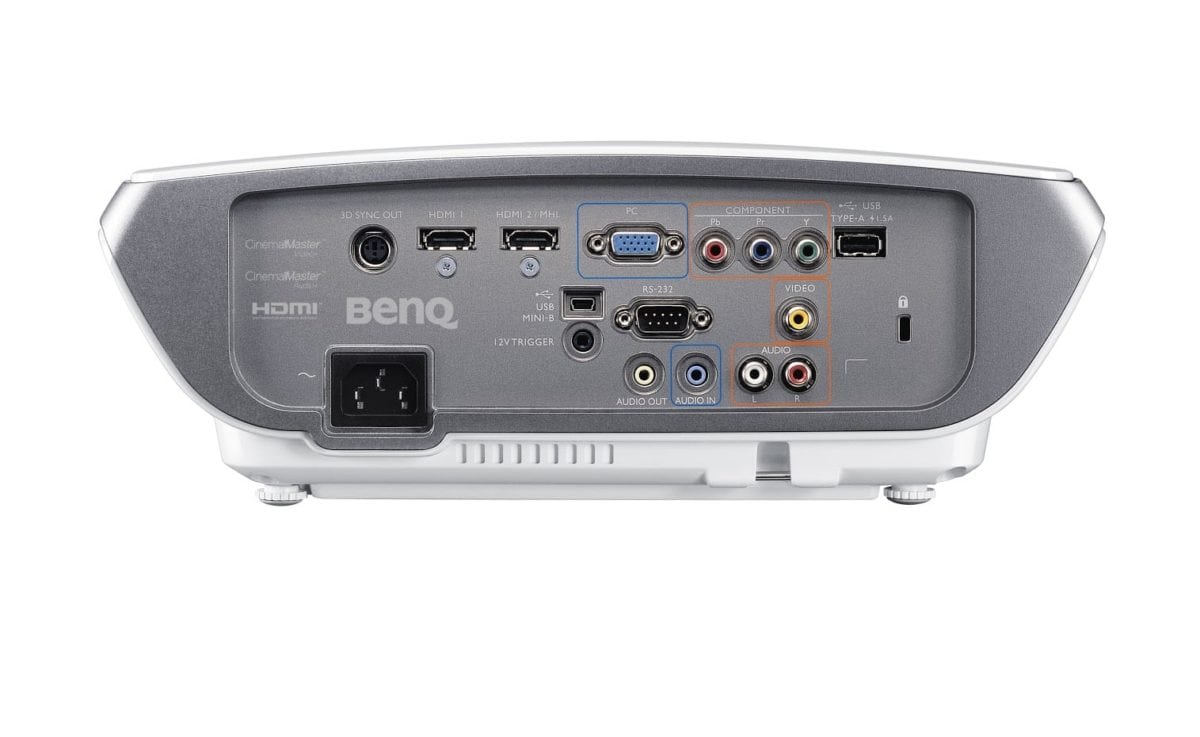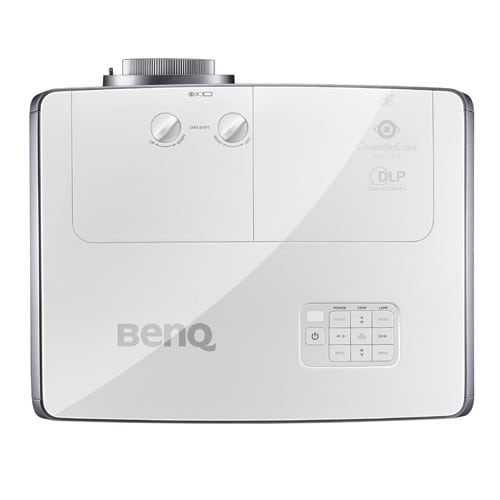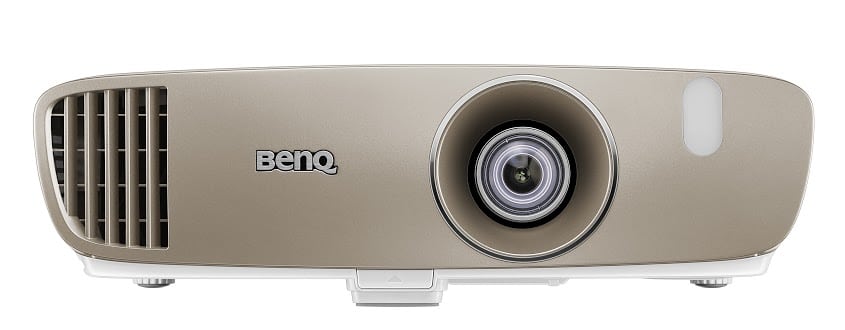BenQ HT3050 Hardware Overview
The BenQ HT3050 home entertainment/home theater projector is moderately small. It's bigger than some competing DLP's and the smallest 3LCD projectors. It's smaller than almost all $2000+ projectors.
As usual we start at the front with the projector's zoom lens, which is recessed and mounted off center closer to the right (if you are facing the projector). the focus and zoom are controlled manually from the recessed lens control area on the top, just back from the lens.
The front also has the front IR sensor for the included remote control, and there's a press to release adjustable drop down foot below the center of the HT3050's front. The only other thing to report on the front is the fan exhaust. The HT3050 - not uncommon for lower cost DLP projectors - leaks a fair amount of light from around the lens controls.
Of course, in a "media" or living room setup with some ambient light present - no one's really going to notice, but put the HT3050 into a dedicated home theater/ cave, or your living room at night with the lights all turned off, be sure to slide closed the cover over the lens controls, otherwise you very likely will see some of the light leakage from that area around the controls hitting the ceiling - if you have the projector sitting table top. Conversely, if ceiling mounted there would be a couple of seats right below the projector getting hit with enough light to be noticeable if you are in that light's path. No worries as long as you remember that sliding door. I forgot about it at first, and had to rewrite this section!
The control panel is located on the top toward the back. It's pretty typical and discussed below. The rest of the "action" is located on the back, where all the inputs and other connectors are located. Underneath, there are a pair of adjustable rear feet to work with the front solo foot. And, as you would expect, there are the obligatory screw thread holes to attach a typical ceiling mount.
The back of the projector houses all the various connectors. And the 10 watt speaker system.
The speaker, btw, sounds pretty good - for what it is. It's fine for the kids, or the backyard movie night, but I have to chastise BenQ like I do everyone else making projectors that have an internal speaker, and a stereo audio out: BenQ should allow the internal speaker to work simultaneously with outputting the audio through the jack. This would be great for almost everyone who lacks a separate high quality sound system to plug into. Why? you ask!
Easy answer, today you can choose from a great many, pretty small, yet powerful, powered subwoofers. They start from perhaps $30 - $40. Plug any of them into the audio out jack, and you will get far better, and lower bass than the speaker in the projector. That would provide a massive improvement when watching action flicks, or listening to music videos, etc. A smart projector manufacturer might even offer bluetooth to feed some sort of external audio system or sub-woofer, but I'm not aware of anyone doing it yet. Either way, sound quality goes way up, with little expense for the projector owner. Well, maybe next generation? I've been pushing at least the first suggestion to manufacturers for several years, still waiting for someone to implement this simple change. Alas!
BenQ HT3050 Lens Throw
| Closest Placement |
100" (2532mm) |
| Furthest Placement |
129.6" (3291mm) |
|
As mentioned elsewhere, placing the projector only 100" away from a 100" diagonal screen is hardly very short throw, but it is shorter than most other home theater projectors except the very few "very" short throw, and ultra short throw projectors. Most of the competition, on the short end of their zoom ranges are 10 feet back to fill 100", so about 20% further back! Most projectors can't be placed closer than 10 feet for the same sized screen, so this is about two feet closer than most can do. That can be a plus for you.
As far as lens shift goes, the amount is relatively modest, If ceiling mounted the center of the lens can be placed in line with the top of the screen surface, or just over six inches above the top. If table top, even with the bottom of screen or the projector can be as much as 6 and change inches below the bottom.
The HT3050 does not have any horizontal lens shift, but considering few competitors have any lens shift at all... A sliding door can cover the lens focus and zoom controls and the lens shift control.
HT3050 Control Panel
The control panel is pretty traditional.
From the left, first you will find the Power button (once for on, twice for off), and right above it the Power indicator LED. The navigation controls - up down left and right arrows - are to the right in a round formation. with the OK button (Enter) in the center.
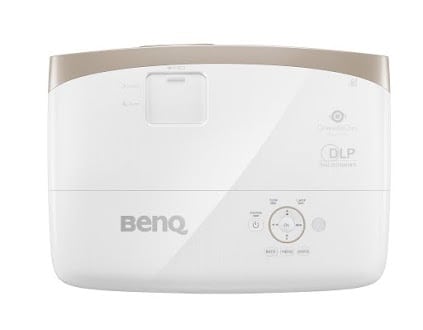
Just above the navigation area (closer to the front of the projector) are two more indicator LEDs. One is for Temperature, the other for Lamp. To the right of the navigation area is the top IR sensor for the remote control. BenQ put it there, instead of on the back where many companies place it.
"Below" the navigation circle are three buttons - from the left are the Back button (takes you back up a level in the menus), then the Menu button itself, and as you've probably figured out, the Source button is on the right.
That almost covers it all, except that each of those four arrow buttons take on a different role when you are not using the menus. The left and right arrow keys instead become volume down and up, respectively. The up and down arrows are for Keystone correction adjustment. That folks covers the control panel!
HT3050 Inputs and Connectors
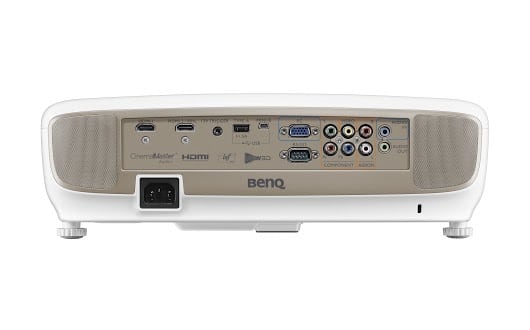
The back panel of the HT3050 is loaded with inputs and connectors, as well as grills covering the two 10 watt speakers
Let's run though everything on the input panel, starting at the top on the left side.
First up are a pair of HDMI inputs. The leftmost one is a standard HDMI, while the right one is HDMI with MHL support (for streaming sticks, interfacing to many mobile devices, etc.) Next over is a small jack which is the 12 volt screen trigger, for controlling a properly equipped motorized screen (so that powering up the projector lowers the screen, turning it off, raises it). Next over are a pair of USB inputs, the first to provide power for BenQ's optional wireless HD device, the other as a service port.
Then comes a standard computer input (a standard HD15 connector), and below it an RS232 serial port for "old school" command and control. Component and composite video inputs are color coded (red green and blue RCA jacks for the component, and a yellow one for composite video.
That leaves only two separate stereo audio inputs and a stereo audio output (to feed a larger sound system).
That's everything on the back except the power receptacle, a Kensington lock slot, and the grills for those two 10 watt speakers.
Since the speakers are rear facing that works well with the short throw design as typically people will be sitting behind the projector where the sound is best.

